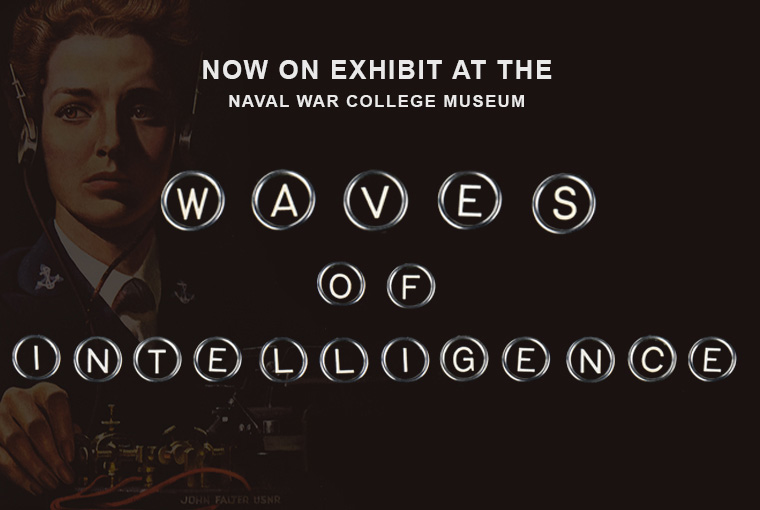Naval War College Museum Announces New Ongoing Exhibit "W.A.V.E.S. of Combat Intelligence"

About this Event
Event Information
Thursday, May 30, 2019
Naval War College Museum, 686 Cushing Road, Newport, RI 02841
NWC Museum
This event is open to the general public
This event is open to the public.About The Exhibit
This exhibit highlights the role of the U.S. Naval War College and the W.A.V.E.S. of Combat Intelligence in global antisubmarine operations during the Second World War. For the very first time since the Second World War, several artifacts and once highly classified "ULTRA" photographs are on display in the museum at Founder's Hall.
Among other featured objects now on display for the first time in the Naval War College Museum:
- Four-rotor German naval enigma cipher machine juxtaposed to a rotor from the U.S. Navy high-speed Bombe machine. The latter essentially worked like a modern computer, which enabled the U.S. Navy to solve German naval communications at a rate faster than the British codebreakers at Bletchley Park and at a rate faster than the German Naval High Command after 1943.
- Personal items from a W.A.V.E.S. cryptanalyst who helped build the high-speed Bombe at Sugar Camp in Ohio before she reported for duty at the U.S. Naval Communications Annex at Nebraska Avenue -- essentially the U.S. Navy equivalent to the British codebreaking facility at Bletchley Park.
- The hand drawn reconstruction of the German naval grid chart cipher, as rendered by reserve Lt. Neil Carson in 1943. Sight unseen, Carson used his education in music to reconstruct the German naval grid by analyzing intercepted enemy communications. Allied sailors subsequently captured an actual copy of the updated German naval grid in the U-505 on June 4, 1944. The reconstructed version by Carson proved highly accurate.
- The five-star uniform of Fleet Adm. Ernest J. King, chief of naval operations and commander in chief, U.S. Fleet. No other officer in the history of the U.S. Navy held equivalent responsibility for the strategic administration and global operations of joint and combined sea services. Among other subordinates of King in the Second World War, Fleet Adm. Chester W. Nimitz relied upon the intelligence provided by the W.A.V.E.S. serving in the Combat Intelligence Division of the Navy Department. Through the "numbered fleets" after 1943, U.S. Navy offensive operations reflected the unseen hand of the W.A.V.E.S. serving under King in the Combat Intelligence Division in Washington, D.C.
- The "King Gray" uniform of retired Capt. Kenneth A. Knowles. Having served in the Asiatic Fleet in the 1930s, Knowles returned to active duty to serve as officer in charge of the Atlantic section under King in the Combat Intelligence Division. After 1943, Knowles supervised the W.A.V.E.S. of Intelligence to conduct global antisubmarine operations to defeat the Axis navies in the war at sea with the distinctive "King Gray" uniform currently on display.
- Binoculars seized on the German submarine U-505 by reserve Lt. Cmdr. Dudley S. Knox, skipper of the USS Chatelain (DE-149). Seventy-five years ago on June 4, Knox participated in the capture of German submarine U-505. Despite orders to turn in souvenirs, Knox kept the pair of binoculars he received from Capt. Daniel V. Gallery, Jr. as a keepsake. For the first time, the family graciously donated the U-505 binoculars for display at the Naval War College.
Most Recent
8:00 a.m.
U.S. Naval War College, 686 Cushing Rd, Newport, RI 02841
U.S. Naval War College, 686 Cushing Road, Newport, RI 02841
U.S. Naval War College, 686 Cushing Road, Newport, RI 02841
8:00 a.m.
U.S. Naval War College, 686 Cushing Road, Newport, RI 02841
U.S. Naval War College, 686 Cushing Rd, Newport, RI 02841
News, Media, & Events
Three U.S. Naval War College Graphic Designers Receive Promotions to Acknowledge Major Changes in Their Work
Apr. 05, 2019
News Publication
Starship Poseidon Summer STEM Camp
Jul. 14, 2019
Naval Station, U.S. Naval War College, 686 Cushing Road, Newport, RI 02841
Lectures of Opportunity: "Three Kings in Newport"
Jun. 10, 2019
Conolly Hall, U.S. Naval War College, 686 Cushing Road, Newport, RI 02841
